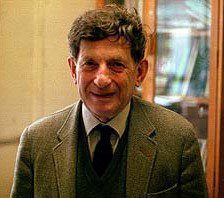UAP, ETI, and David Bohm’s Physics, UFO 22

UAP, ETI, and David Bohm’s physics. Why might these be connected? Because, as we noted in earlier posts in this UFO series, we are looking for an ontology. The UFO phenomenon evokes within our curiosities a quest for reality, for ultimately reality. Much more than mere curiosity is at stake. We want to know what’s really real.[1]
A century ago, the greatest minds in physics competed like two football teams. The goal? To explain the path of the electron. The alleged winner was the quantum indeterminist theory quarterbacked by the Copenhagen School headed by Niels Bohr and Werner Heisenberg. The alleged loser — the deterministic interpretation of sub-atomic quantum activity — was captained by Albert Einstein and with teammates such as David Bohm.
I got to meet David Bohm during a 1983 colloquium hosted by the Center for Theology and the Natural Sciences (Peters, David Bohm, Postmodernism, and the Divine 1985). I was impressed, especially with Bohm’s notion of holomovement. I incorporated nature’s holomovement into my category of history when I wrote my systematic theology, God—The World’s Future (Peters, God--The World’s Future, 480). Along with my physicist colleague, Carl Peterson, I’m still investigating Bohm’s quantum theory (Peters & Peterson, 2013) while Orthodox theologians assess Bohm’s theological significance(de Grijis, 2023).
Might UAP, ETI, and David Bohm’s physics converge? Yes, indeed, according to one of the most profound of our UAP theorists, Jensine Andresen. What Andresen does is employ Bohm’s physics as an ontology to explain UAP along with everything else. Or, perhaps it’s easier to think of it this way—because Bohm’s ontology explains everything in reality, Andresen states that it can shine a light on what’s happening in UFO experience.
I would like to follow the trail of breadcrumbs left by independent UFO researcher Jensine Andresen that leads us through Bohm’s physics to the cosmic home we terrestrials share with our extraterrestrial neighbors.
1 UAP needs ontology to explain it.

Our very experience of an unidentified flying object can knock us on our heels. We ask immediately: “what is that?” A moment later we may ask: “what is real and what is not real?” That’s why we need ontology, according to Jensine Andresen.
Where might we go for an ontology that explains everything in reality? To David Bohm’s physics.
“Discussion of the ETI/UAP topic must occur within the context of a broad discussion of ontology—for example how ontology is understood within the context of the quantum theory. Here, Bohm’s interpretation of the quantum theory, which is ontological by design, helps guide us towards the clearer ontological view that ETI already possesses” (Andresen, Bohm’s Interpretation of Quantum Theory, 50).
Note that Andresen believes ETI already possess the very knowledge of the universe which David Bohm adumbrates. And then some! This implies that our extraterrestrial neighbors are more advanced in science and technology than we terrestrials are.[2] Could extraterrestrials help us by sharing what they know about advanced energy systems? Would they want to? Or, as Andresen argues, might they want us to get our ethical house in order first, to ensure that we do not weaponize what we learn.
2 UAP needs an ontology that unites subjectivity and objectivity.
What has been so dumbfounding for scientists is that anomalous objects are not merely objects. They also have mental aspects. “Some UAP appear both mental and physical at the same time.” (Andresen, Mind of the Matter, Matter of the Mind 2022, 301-303). UFOs can be as much mental as physical, as much subjective as objective. Indeed, argues Andresen, following Bohm, that is because mind and matter are inseparable. Therefore, we need an ontology that is more comprehensive than datacentric science alone can give us.
Does Bohm provide an ontology that explains the inseparability of mind and matter, and, accordingly, therefore also unites subjectivity and objectivity? Yes. How? By helping us understand that the distinction we make between mind and matter is not correct, and by pointing us to perception of the implicate order.[3] Actually, reality is the reverse of how most people habitually perceive it to be. What is primary is the implicate order of the whole of reality. What you and I experience is a partial unfolding of the implicate order within our explicate experience.
3 Andresen borrows Bohm’s distinction between the explicate order in our experience, on the one hand, and the subtle but ever present implicate order, on the other hand.

“Most of the major UFO research organizations stressed the importance of developing good scientific methodology for investigating UFO encounters and tried to teach that methodology to the amateur investigators,” observes Brenda Denzler (Denzler 2001, Kindle 1103-1104).
But that’s not good enough, argues Andresen. Today’s scientific method presupposes naturalism—that is, the belief that physical nature constitutes all there is to reality. So, Andresen cites David Bohm to make the point that there is more to reality than just what we perceive. “Driving most of human society today is the idea that what Bohm refers to as explicate order is the entirety of existence. It is not. It is only the ripples on the infinite ocean that Bohm refers to as implicate order” (Andresen, Hyperconflation, 97). Thus, we need to attend to the implicate order in constructing our ontology.[4]
The following is a deep paragraph. Put on your intellectual rubber boots to wade through it. This is the heart of the Andresen-Bohmian ontology.
“ETI/UAP can manifest and unmanifest (i.e., appear and disappear) at will from detection by human observers and their instruments. My view is that in certain circumstances, this involves manifesting from implicate to explicate order and unmanifesting from explicate to implicate order. In other words, ETI/UAP sometimes make a conscious and intentional transition back and forth between implicate and explicate levels of order. The implications of this are profound. At a minimum, it means that ETI understands the genesis and constitution of form and the process and dynamics of manifesting and unmanifesting. Essentially, then, ETI/UAP can reconstitute themselves at will at different points in spacetime. Literally, ETI/UAP are demonstrating how the infinite becomes finite and how the finite becomes infinite” (Andresen, Bohm’s Interpretation of Quantum Theory, 53-54).
Can the finite contain the infinite? Yes, according to Bohm’s physics which views each part of reality as a hologram. The hologram makes the whole present within the part.[5]
4 Our ETI visitors will necessarily be benevolent.
One of the unique tenets of the Andresen-Bohm ontology is the assertion that the laws of physics gradually lead us to greater cooperation and even to altruism. We’ve previously noticed how proponents of the ETI Myth such as Carl Sagan and Frank Drake assumed that longer evolution leads to higher intelligence and therefore to higher morality. Here Andresen undergirds this evolutionary biology with directional physics. Her conclusion: more highly advanced ETI—specifically an ETI that has mastered physics to the level of bringing General Relativity and quantum theory together in some sort of unified view, which means de facto it has mastered gravity—will also be benevolent. Otherwise, with all but infinite energy on their hands, were they not benevolent, they would have rendered themselves extinct by now on account of weaponizing such vast reserves of energy (a dystopian fate she really wants to keep out of reach of human beings).
“From the perspectives both of physics and of evolutionary biology, a sophisticated ETI will have evolved to be altruistic” (Andresen, Bohm’s Interpretation of Quantum Theory, 47)
More. More advanced and more altruistic ETI are coming to earth to share with us the blessings of cooperation, kindness, and benevolence.
“Becoming aware of ETI’s kind and gentle nature will help human beings cultivate and embody a cooperative disposition towards ETI … Embodying a disposition of kindness will help us realize true security and sustainability for our own species, for other species, for Earth, and for the whole” (Andresen, Bohm’s Interpretation of Quantum Theory, 49).
5 Might we think of ETI as our celestial saviors?

To be clear, Andresen herself does not speak in terms of salvation. But I would suggest that the human race on Earth is fallen, in need of celestial saviors in the form of more highly intelligent aliens.
“To ETIs…human beings must appear profoundly immature in their impulses and outbursts, particularly those that hurt and kill other human beings, eradicate other species, and damage the environment….ETI has good reason to be concerned about humanity, which is at the brink of annihilating itself.” (Andresen, Mind of the Matter, Matter of the Mind 2022, 305).
If we on earth respond positively to our celestial visitors, we may become blessed. Indeed, any opportunity to interject grace into our existence should be both recognized and acted upon.
“Wholeness, peace, justice, and love all are present and available to everyone—human and extraterrestrial alike” (Andresen, Hyperconflation, 97).
6 It would be a mistake for us to treat ETI as hostile invaders
What worries Jensine Andresen is the circulating idea that UAP respresent a threat to natural security or, worse, an existential threat to the wellbeing of us on Earth. Luis Elizondo stirs up anxiety with threat discourse.
“UAP, and the nonhuman intelligence controlling them, present at best a very serious national security issue, and at worst the possibility of an existential threat to humanity” (Elizondo 2024, 1).
UAP does not present a national security issue, counters Andresen. “ETI/UAP are not a threat to humankind” (Andresen, Bohm’s Interpretation of Quantum Theory, 49).
Andresen wants to avoid a terrestrial panic that aims a missile at the next anomalous craft we see in the sky. It would be a grave mistake to shoot down our heavenly friends. “ETI/UAP are not a threat to humankind” (Andresen, Bohm’s Interpretation of Quantum Theory, 49).
We do not need to add protection against UAP to the national defense budget. In fact, suspicion that ETI might be hostile could unintentionally precipitate a preventive military strike against our otherwise benevolent visitors.
Jensine Andresen on UAP, ETI, and David Bohm’s Physics
The focus of Jensine Andresen’s argument is that Bohm’s ontological interpretation of quantum theory is the best interpretation of quantum physics that we have. Bohm’s ontology helps us to understand anything and everything from a physics perspective. Accordingly, it is the best framework we have to date that can be brought to bear on ETI/UAP.
Conspectus
Because UAP exhibit both physical and mental traits, UAP should be investigated both objectively and subjectively. The value of scientific research is that it can provide illuminatiung data regarding the physical aspects of unidentified aerospace objects. But, the limit of scienctific research is that it makes no room for what is mental, conscious, or subjective. UAP investigation requires an expanded discipline to study.

Because some UFO experiencers claim they are confronted by a reality more real than ordinary daily life, the philosopher asks: is it time for an ontology?
Jensine Andresen answers, “yes.” The ontology she recommends is the carefully constructed dynamic worldview proposed by noted physicist, David Bohm. Of special interest to Andresen is Bohm’s subtle interaction between the holistic implicate order and the pluralistic explicate order. UFOs, accordinglly, manifest themselves from implicate to explicate order. Further, UFOs unmanifest themselves from explicate to implicate order. The extraterrestrials behind UAP sometimes make a conscious and intentional transition back and forth between implicate and explicate levels of order. This is a coherent physical as well as metaphysical hypothesis.
The implications of this are profound, she contends. At a minimum, this means that ETI understands the genesis and constitution of form right along with the process and dynamics of manifesting and unmanifesting. Essentially, then, the nonhuman intellgiences responsible for UAP can reconstitute themselves at will at different points in spacetime. Literally, ETI are demonstrating how the infinite becomes finite and how the finite becomes infinite”
Did you get all that? If you’re ready for more, click on some items below.
SR 1192 UFO 22 UAP, ETI, and David Bohm’s Physics
SR 1177 UFO 7 Are UFOs demonic?
SR 1186 UFO 16 UAP Cryptoterrestrial Hypothesis
SR 1187 UFO 17 Scientizing Ufology
SR 1188 UFO 18 Are UAP from outer space?
SR 1189 UFO 19 Are UAP from future time?
SR 1190 UFO 20 UAP: The Interdimensional Hypothesis?
SR 1191 UFO 21 UAP and Ancient Alien Theology
SR 1192 UFO 22 UAP, ETI, and David Bohm’s Physics
SR 1195, UFO 25. UAP in the Nation of Islam?
▓

Ted Peters directs traffic at the intersection of science, religion, and ethics. Peters is an emeritus professor at the Graduate Theological Union, where he co-edits the journal, Theology and Science, with Robert John Russell on behalf of the Center for Theology and the Natural Sciences, in Berkeley, California, USA. He authored Playing God? Genetic Determinism and Human Freedom? (Routledge, 2nd ed., 2002) as well as Science, Theology, and Ethics (Ashgate 2003). Along with Martinez Hewlett, Joshua Moritz, and Robert John Russell, he co-edited, Astrotheology: Science and Theology Meet Extraterrestrial Intelligence (2018). Along with Octavio Chon Torres, Joseph Seckbach, and Russell Gordon, he co-edited, Astrobiology: Science, Ethics, and Public Policy (Scrivener 2021). Along with Arvin Gouw and Brian Patrick Green, he co-edited Religious Transhumanism and Its Critics (Lexington 2022). Look for his newest book, The Voice of Public Theology, a collection of previous articles. See his website: TedsTimelyTake.com.
Regarding UFOs, he is author of UFOs: God’s Chariots? Spirituality, Ancient Aliens, and Religious Yearnings in the Age of Extraterrestrials (Career Press New Page Books, 2014). He served as Louisiana State Director for MUON and is currently a member of two UFO investigation organizations, Society for UAP Studies and Scientific Coalition for UAP Studies.
▓
Notes
[1] Mircea Eliade observed that the human race exhibits ontological thirst—that is, a thirst to know reality (Eliade 1957, 64). Jensine Andresen alerts us that only a good ontology can slake that thirst. “If human beings do not perceive reality correctly – or even well – then their responses to the actual reality in which they are immersed will be maladaptive. To become adaptive, human beings must perceive and interpret reality accurately and they must adjust their own cognitive and emotional responses accordingly” (Andresen, Cartographies of Knowledge and Academic Maps 2022, 4).[2] Have ETI already learned how to fly from star to star at supra-luminal speed? Phsycist Hal Putoff appeals to Einstein, not Bohm, to make an affirmative case. “Engineering Einstein’s GR equations can, in principle, lead to a series of vastly advanced and seemingly other worldly technological possibilities. Of particular interest are those technological advancements that can lead to advanced aerospace craft … [with] the availability to travel at superluminal speeds relative to the reference frame of background space” (Puthoff, 2023).
[3] Mind, matter, and the whole. They all belong together, according to David Bohm. “The whole universe is in some way enfolded in everything and that each thing is enfolded in the whole. From this it follows that in some way, and to some degree everything enfolds or implicates everything, but in such a manner that under typical conditions of ordinary experience, there is a great deal of relative independence of things. The basic proposal is then that this enfoldment relationship is not merely passive or superficial. Rather, it is active and essential to what each thing is. It follows that each thing is internally related to the whole, and therefore, to everything else. The external relationships are then displayed in the unfolded or explicate order in which each thing is seen, as has already indeed been indicated, as relatively separate and extended, and related only externally to other things. The explicate order, which dominates ordinary experience as well as classical (Newtonian) physics, thus appears to stand by itself. But actually, it cannot be understood properly apart from its ground in the primary reality of the implicate order” (Bohm 1990, 273).
[4] The naturalistic assumption adhering to science has become our tacit social ontology, according to philosopher Michael E. Zimmerman. “The social ontology [a culture’s conceptual set] of modern democracies is usually an aggregate of naturalistic materialism and anthropocentric humanism” (Zimmerman, 1997, 238).
[5] Bohm’s holographic principle reminds the theologian of the debate between John Calvin and Martin Luther. Can the finite contain the infinite? No, said Calvin, finitum non capax infiniti. Yes, countered Luther, finitum capax infiniti. Luther relied on the capacity of the finite to contain the infinite to undergird the truth of God’s incarnation in Jesus Christ. Today’s followers of Luther seem to be unaware of the Bohmian explanation that could complement this theological position.
References
Andresen, Jensine. Bohm’s Interpretation of Quantum Theory: Implications for Extraterrestrial Intelligence (ETI) and Unidentified Anomalous Phenomena (UAP). New York: Andresen, 2023.
__. “Cartographies of Knowledge and Academic Maps.” In Extraterrestrial Intelligence: Academic and Societal Implications, by eds Jensine Andresen and Octavio Chon Torres, 1-6. Cambridge UK: Cambridge Scholars Press, 2022.
—. Hyperconflation: Recommending a Relational Alternative to the Datacentric Approach to UAP. New York: Andresen, 2023.
—. Hyperconvergenece: Religion, Politics, and UFOs. New York: Andresen: https://www.goodreads.com/book/show/197292604-hyperconvergence, 2023.
Bohm, David. “A New Theory of the Relationship of Mind and Matter.” Philosophical Psychology 3, no. 2 (1990): 271-286.
Denzler, Brenda. Lure if the Edge: Scientific Passions, Religious Beliefs, and the Pursuit of UFOs . Berkeley CA: University of California Press, 2001.
de Grijis, Richard; and Doru Costache, 2023. “The Cosmology of David Bohm: Scientific and Theological Significance,” Theology and Science 22:1: 204-220; https://www.tandfonline.com/doi/full/10.1080/14746700.2023.2294529.
Eliade, Mircea. The Sacred and the Profane. New York: Harcourt Brace and World, 1957.
Elizondo, Luis, Imminent. New York, Harper, 2024.
Peters, Ted. “David Bohm, Postmodernism, and the Divine.” Zygon 20:2, 1985: 193-217.
—. God–The World’s Future: Systematic Theology for a New Era. 3rd. Minneapolis MN: Fortress Press, 2015.
_, and Carl Peterson. “The Higgs Boson: An Adventure in Critical Realism.” Theology and Science 11, no. 3. (2013): 185-217. https://www.tandfonline.com/action/showCitFormats?doi=10.1080/14746700.2013.809948.
Puthoff, Harold E. “Space-time Metric Engineering: The Possibility and Challenge of Utilizing GR (General Relativity) Technologies.” SCU News 4:4 (October 27, 2023).
Zimmerman, Michael. “The alien abduction phenomenon: Forbidden knowledge of hidden events.” Philosophy Today 41:2, 1997: 235-245.














